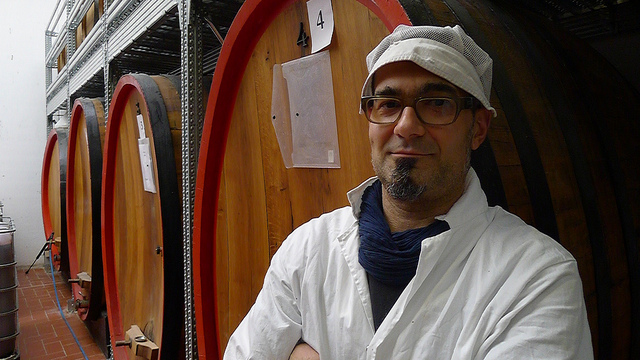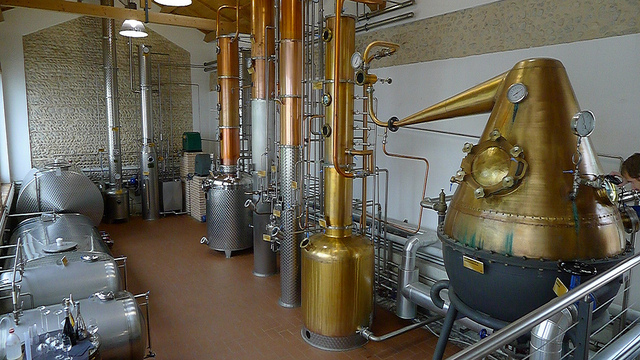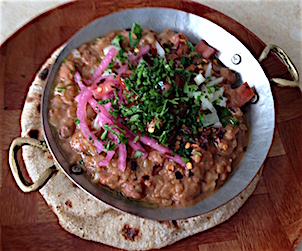It has to be said that until relatively recently grappa was a complete mystery to me. I had found the many examples I had tasted over the years to be quite harsh, and brutal upon my oh-so-sensitive palate.
That was until I paid a visit to Bottega‘s grappa producing facility, where I met the friendly and enthusiastic Andrea Minguzzi, who gave me my first real lesson into what makes for a good grappa.
Bottega, although known the world over for their Prosecco, actually have their roots in the production of grappa, and so I was in good hands joining them for my grappa 101…
Good Food Revolution: So, for our GFR audience, how would you describe your position at Bottega?
Andrea Minguzzi: My function at Bottega is to prepare grappas and liqueurs before they are bottled. I work to perform the best possible production procedures, and to constantly improve our products, teaming up with the research and development department.
GFR: And how important is the distillation side to Bottega’s portfolio compared to other areas?
AM: Bottega SpA was established in 1977 as a distillery, hence grappa represents the origins of the company, and has been its most important product for years. Nevertheless, Prosecco and sparkling wines have now taken over the bigger portion of the portfolio, and it is likely that this trend will continue in the future.
GFR: In your mind, what sets Grappa apart from other distillates?
AM: The aromatic complexity of the various grapes make Grappa a very varied, diverse product. Grappa is a unique and flavoursome spirit, it is versatile and has a great consumption potential, also due to the many different consumption options: it can be either drunk after a meal, on its own, in coffee, as an ingredient for cocktails or even for Italian cuisine recipes.
GFR: Please describe the specific method you use to produce your Grappa at Bottega?
AM: I start by preparing a mixture of grappa, demineralized water and sugar (in a very low percentage, maximum of 1%). I cool the mix down to about -20 °C, to ensure that all oils become solid and are easily removed by filtration. Filtration comprises two steps: the first eliminates the coarser parts, the second obtains a perfectly transparent product, akin to water. This process allows me to get a milder grappa, easy to digest, smooth on the palate and suitable for all tastes – including younger people and women.
GFR: And what would you say to those who turn their nose up at Grappa, saying it is too rough for them?
AM: I would say that probably they have not tasted a Grappa by Bottega! The are generally known to be smooth and easy to drink!
GFR: And so what is it that makes for a smoother style of Grappa?
AM: The preparation is an important part of the process; by the way, distillation is also crucial. Like all secondary processes, distillation enhances all the original features of the raw material: we will get a good spirit only if the pomace (raw material) is a good quality material.
GFR: How did you find yourself in this particular role? Did you set out to become a Grappa maker? What paths led you here?
AM: When I attended the Oenology High School in Conegliano – the oldest Oenology school in Italy – grappa was not a main subject. While lately it has gained the importance it deserves, becoming a more important studying subject. But I have learnt most of the things I know now, while working.
GFR: How many different grappas do you make at Bottega?… and at the end of the day how do they differ?
AM: They are too many to be counted! They differ because there are single varietal grappa (made from pomace obtained from one single grape) and blended grappa (made from pomace obtained from different grapes). Moreover, there are “young” grappas and “aged” grappas: and this is the aspect that I like the most.
GFR: And do you believe that the single varietal or blended, say Amarone, Grappas are better?
AM: I personally wouldn’t say that single varietal are better than blended, or the contrary. This is more a matter of taste. While, I would say that aged grappa are more complex and intriguing.
GFR: I’m always surprised that tannins (and/or pigment) from a more tannic (and/or pigmented) wine make it all the way through those distillations to the final product?
AM: Yes, and this is what differentiates grappa from other distillates.
GFR: Now Ageing of Grappa is a relatively recent development… What are your thoughts on that and what do you believe it brings to the glass?
AM: As I said before, I love aged grappas. Due to its complexity, grappa ages very well. Moreover, the grappa maker can choose between many ageing options: e.g. selecting from a wide range of wood types and different toasting of the barrels, resulting in great products of very high quality.
If you are having trouble viewing this video please click here.
GFR: In your mind, what is the perfect way to serve Grappa?
AM: It depends on the type of the grappa: a young grappa can be served at room temperature, even “on the rocks”. While, in my opinion, an aged grappa or a very aromatic grappa should be served at room temperature. The choice of glasses is also very important; and, after swirling the glass, one should wait a few seconds before smelling – otherwise the aromas are overwhelmed by the alcoholic sensation.
GFR: I’ve heard that having Grappa alongside coffee is a good way to analyse the product, as doing so highlights both the flaws and the positives… is there any truth in this?
AM: I don’t think so. Yet, drinking grappa alongside a good coffee, possibly espresso, is always a good choice!
GFR: Grappa has seen a fair bit of use in cocktail culture as of late… do you have any favourite applications there?
AM: Well I am not a cocktails’ lover. But I think grappa, thanks to its personality, always leaves its mark, wherever and however it is used.
GFR: Honestly… how much Grappa do you consume in a week?
AM: I am lucky enough to taste a lot of grappa when I am working. So, when I am not at work, I don’t drink a lot of grappa – and I only drink aged grappa
GFR: Andrea, thank you so much for your time. Much appreciated.

Edinburgh-born/Toronto-based Sommelier, consultant, writer, judge, and educator Jamie Drummond is the Director of Programs/Editor of Good Food Revolution… And he’s learning to appreciate the finer side of grappa.









